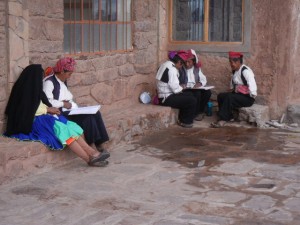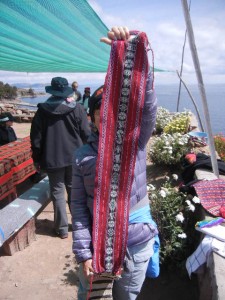20 May: Our next place to visit in Peru was Lake Titicaca, where we spent three nights. At 12,500 feet of elevation, this is the highest navigable lake in the world. It was home to the ancient Tiwanaku civilization, known for its impressive stone temples and exquisite art long before the time of the Incas. Some elements of Incan culture (and perhaps even the people themselves) may have originated here before becoming established in Cusco. Lake Titicaca is also where Thor Heyerdahl had his reed boat Kon Tiki constructed by ancient methods for his famous voyage from South America to Polynesia in the 1950s. To get there from Cusco, we had front row seats on the upper deck of a big inter-city bus, giving us a nice view of the high country. We spent our first night in the port city of Puno, where we met a water engineer professor friend of Abby’s for hot chocolate. He showed us his wife’s collection of family stones. These are small locally carved stone items that are treasured heirlooms, each representing a specific family, brought out on special occasions to appeal for good fortune. Later we walked among the local markets and had a nice dinner at a restaurant on the main square (trout kabobs and roasted lamb).
21 May: Our main activity at Lake Titicaca was a two-day, one-night, tour by boat to an island for a home stay with a local family. Shortly after leaving the Puno waterfront, our tour boat stopped near the mouth of the bay to visit one of the floating islands. These small islands are floating platforms constructed from the local marsh reeds, each large enough to support a few reed huts. They were originally built when the people took refuge from the Spanish conquistadors, and roughly 2,000 Aymara-speaking people live there to this day, subsisting mainly on fishing, supplemented by tourism. Our tour guide gave a talk about the lake in general and the floating islands in particular. We took a short ride on one of the traditional reed boats and had a chance to learn about the construction and maintenance of the islands and to see the huts and admire the colorful embroidery created there. Each island must be rebuilt after about 9-10 years, with reeds freshly harvested from a protected reserve on the lake’s shore. Trout were introduced into the lake in the 1930s by Peru and kingfish were introduced in the 1940s by Bolivia. Those predatory species have devastated the populations of the smaller native fish.
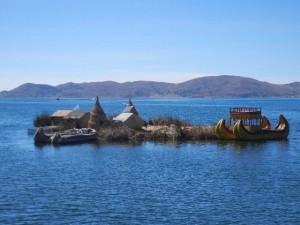
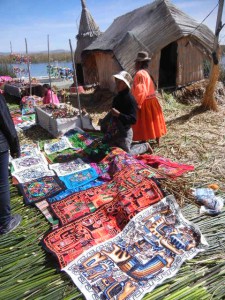
The tour boat continued about two and a half hours to our overnight destination, Amantini Island, out in the main part of this very large lake. Our hosts met us at the landing and took us to their homes for lunch. The ten communities on Amantini Island take turns hosting tourists as a boost to their economies. Our host, Eduardo, spoke Spanish in addition to the native Quechua of the island, so Abby was able to converse with him and translate for us. In the late afternoon, our tour group reconvened in the town’s main plaza for another talk by our tour guide and a two-hour hike up to the top of the island and back to see the temple dedicated to Pachatata (Father Earth). The fairly steep slopes of the island are terraced to grow crops of corn, quinoa, barley, squash, sweet potatoes, peas, beans, lentils, and lupines (which they raise for the edible beans)—the people here are vegetarian. Each meal was accompanied by muᾔa tea, made from a fragrant herb believed to be good for digestion and altitude. After dinner, we were dressed by our host families in traditional costume and met in the local community hall for traditional Andean music and dancing.
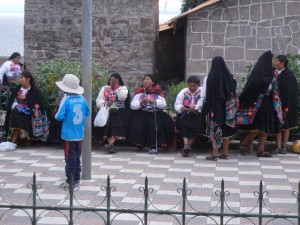
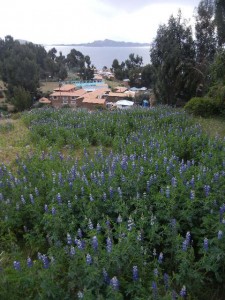
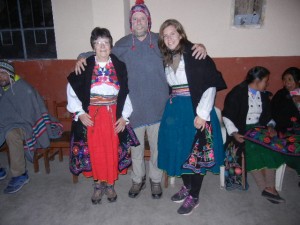
22 May: On the way back to Puno, our tour boat stopped at Taquile Island for a few hours. We hiked up to the main town square, had some time there to browse around, then hiked along the shore to a restaurant for another informative talk by our guide and to eat lunch before our return the trip to Puno. On Taquile, elderly men, rather than women, are the ones who produce most of the traditional knitted items for the tourist trade. The island is also known for mashing a local plant into a frothy pulp and straining it to make a foamy solution that makes an excellent soap or shampoo (our guide demonstrated the process). It has no chemicals, is effective in washing raw wool, and is said to keep hair from turning white. We also learned how the colors of traditional Taquile clothing such as hats and sashes signify things like the age and marital status of the wearer.
